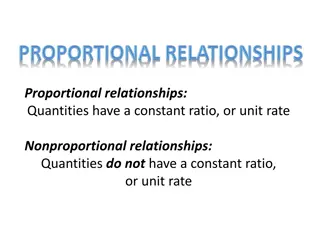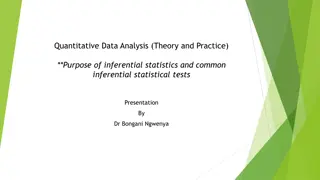Understanding and Representing Quantitative Relationships
Explore how to represent and analyze quantitative relationships using graphs, tables, and equations. Practice with unit rates, plotting points in a coordinate plane, and understanding independent and dependent variables. Develop skills in creating equations, tables, and graphs to model relationships between variables. Engage with essential questions to deepen your understanding of quantitative relationships and their applications.
Download Presentation

Please find below an Image/Link to download the presentation.
The content on the website is provided AS IS for your information and personal use only. It may not be sold, licensed, or shared on other websites without obtaining consent from the author. Download presentation by click this link. If you encounter any issues during the download, it is possible that the publisher has removed the file from their server.
E N D
Presentation Transcript
Lesson Represent and Analyze Quantitative Relationships
[OBJECTIVE] The student will represent and analyze quantitative relationships in graphs, tables, and equations.
[MYSKILLS] Unit rates Plotting points in the coordinate plane Equations
[ESSENTIALQUESTIONS] 1. Explain the meaning of an independent variable. 2. Explain the meaning of a dependent variable. 3. Explain how you can use the information given in an equation to model the relationship using a table and coordinate plane.
[Warm-Up] Begin by completing the warm-up for this lesson.
SOLVE Problem Introduction REPRESENT AND ANALYZE QUANTITATIVE RELATIONSHIPS
[LESSON] SOLVE Jennie helps her grandmother every week one day after school. Her grandmother gives her $15 every week. Write an equation that can be used to represent the relationship between the total she earns (y) and the number of weeks worked (x). Create a table to model the relationship for 4 weeks, 8 weeks, 12 weeks, and 16 weeks and graph the relationship on a coordinate plane.
[LESSON] SOLVE S Study the Problem Underline the question.
[LESSON] SOLVE Jennie helps her grandmother every week one day after school. Her grandmother gives her $15 every week. Write an equation that can be used to represent the relationship between the total she earns (y) and the number of weeks worked (x). Create a table to model the relationship for 4 weeks, 8 weeks, 12 weeks, and 16 weeks and graph the relationship on a coordinate plane.
[LESSON] SOLVE S Study the Problem Underline the question. This problem is asking me to find the equation, table and graph to represent the relationship between the number of weeks worked and Jennie s earnings.
Variables When we write and evaluate expressions that have unknown values we can use a __________ to represent the unknown value. variable A variable is a ________ that we can use to represent any number. We use the term variable because the value _________ based on the expression. letter changes
Variables Example: Brian mows two lawns every day. How many total lawns will he mow during summer vacation? What information do we know? He mows 2 lawns each day. What information do we not know? How many days he mows and the total lawns mowed.
Variables Example: Brian mows two lawns every day. How many total lawns will he mow during summer vacation? How can we represent the relationship between the two values? By using variables What are the two most common letters we use to represent unknown values? x and y
Variables Example: Brian mows two lawns every day. How many total lawns will he mow during summer vacation? What is the relationship between the number of days and the number of lawns? Brian mows ___ lawns for every ___ day. 2 1 Let s read that statement again: Brian mows 2 lawns for every 1 day.
Variables Example: Brian mows two lawns every day. How many total lawns will he mow during summer vacation? What information do we know from the problem? Brian mows two lawns per day. Will we represent that value with a variable? Explain your answer. No, because that is a constant value.
Variables Example: Brian mows two lawns every day. How many total lawns will he mow during summer vacation? What is one unknown in our problem? The number of days mowed Identify the words in the problem that describe that unknown. every day
Variables Example: Brian mows two lawns every day. How many total lawns will he mow during summer vacation? Explain how that is an unknown. We know that he mows 2 lawns every day, but we do not know how many days he mows. Circle the words that describe the unknown.
Variables Example: Brian mows two lawns every day. How many total lawns will he mow during summer vacation? What is the second unknown in the problem? The total lawns mowed Circle the words that describe this unknown.
Variables When we are working with two variables in a situation, one of them changes and one is affected by the change. Example: As your feet grow in length, you must buy a bigger shoe. These values vary from person to person. In the shoe situation, which variable changes? The length of the foot Explain this. The foot growth happens and determines what size shoes you must have.
Variables What two letters are we using to represent the variables or values that change? x and y x We use the variable __ to represent the value that changes. In our foot/shoe scenario, which value changes? The length of the foot
Variables What two letters are we using to represent the variables or values that change? x and y y We use the variable __ to represent the value that is affected by the change. In our foot/shoe scenario, which value is affected by the change of the foot size? The shoe size
Variables Example: Brian mows two lawns every day. How many total lawns will he mow during summer vacation? x number of days Brian mows We have two variables circled in the problem. Which variable changes? The number of days What letter will we use to represent that variable? x
Variables Example: Brian mows two lawns every day. How many total lawns will he mow during summer vacation? x number of days Brian mows The variable that changes is called the independent variable.
Variables Example: Brian mows two lawns every day. How many total lawns will he mow during summer vacation? y total lawns mowed x number of days Brian mows We have two variables circled in the problem. Which variable is affected by the number of days Brian mows? the total lawns What letter will we use to represent that variable? y
Variables Example: Brian mows two lawns every day. How many total lawns will he mow during summer vacation? y total lawns mowed x number of days Brian mows The variable y is affected by the change in the first variable. This is called the dependent variable because its value changes based on the value of the independent variable.
Variables Example: Brian mows two lawns every day. How many total lawns will he mow during summer vacation? y total lawns mowed x number of days Brian mows What does this mean in the situation with Brian? total number The ______________ of lawns mowed is determined by ________________ he mows. how many days
Identifying Variables in a Table Example: Brian mows two lawns every day. How many total lawns will he mow during summer vacation? y total lawns mowed x number of days Brian mows Identify the independent variable, or x-value. the number of days Brian mows Identify the dependent variable, or y-value. the total lawns mowed
Identifying Variables in a Table (x) (y) 1 2 3 4 x 2 We can represent the relationship between these two values in a table.
Identifying Variables in a Table Days Brian Mows (x) (y) 1 2 3 4 x 2 What is the label for the first column? Days Brian mows
Identifying Variables in a Table Let s use our paper square to represent the days. Place one paper square on the work space.
Identifying Variables in a Table Days Brian Mows (x) (y) 1 2 3 4 x 2 What variable is used to represent the days Brian mows? The independent or x-value
Identifying Variables in a Table Days Brian Mows (x) (y) Total Lawns Mowed 1 2 3 4 x 2 What is the label for the second column? Total Lawns Mowed
Identifying Variables in a Table Let s use our yellow tiles to represent the number of lawns mowed.
Identifying Variables in a Table How many lawns did Brian mow in one day? two Place two yellow unit tiles on the paper square.
Identifying Variables in a Table Days Brian Mows (x) (y) Total Lawns Mowed 1 2 3 4 x 2 What variable is used to represent the total lawns mowed? The dependent or y-value
Identifying Variables in a Table Days Brian Mows (x) (y) Total Lawns Mowed 1 2 3 4 x 2 What information do we know? He mows two lawns every day.
Identifying Variables in a Table Days Brian Mows (x) (y) Total Lawns Mowed 1 2 3 4 x 2 What is the first value given in the x-column? 1
Identifying Variables in a Table Days Brian Mows (x) (y) Total Lawns Mowed 1 2 3 4 x 2 Explain what this value of 1 represents. It means that Brian mowed one day.
Identifying Variables in a Table Days Brian Mows (x) (y) Total Lawns Mowed 1 2 3 4 x 2 What do we know about the number of lawns Brian will mow in 1 day? He mows 2 lawns in one day.
Identifying Variables in a Table Days Brian Mows (x) (y) Total Lawns Mowed 1 2 3 4 x 2 What number is written in the y-column where x is equal to 1? 2
Identifying Variables in a Table Days Brian Mows (x) (y) Total Lawns Mowed 1 2 3 4 x 2 What does this mean? When Brian mows one day, he will mow 2 lawns.
Identifying Variables in a Table Example: Brian mows two lawns every day. How many total lawns will he mow during summer vacation? y total lawns mowed x number of days Brian mows Let s read the scenario about Brian again.
Identifying Variables in a Table Days Brian Mows (x) (y) Total Lawns Mowed 1 2 3 4 x 2 Does our first row of information in the table match our scenario? Yes, because the problem tells us that for every 1 day, he mows 2 lawns.
Identifying Variables in a Table Days Brian Mows (x) (y) Total Lawns Mowed 1 2 3 4 x 2 What is the next row of the x-column? 2
Identifying Variables in a Table Days Brian Mows (x) (y) Total Lawns Mowed 1 2 3 4 x 2 If we are using the paper squares to represent the days he mows, how many paper squares do we use? 2
Identifying Variables in a Table Let s place 2 paper squares on the work space. How many lawns does Brian mow each day? 2 How many yellow tiles do we place on each square? 2
Identifying Variables in a Table What is the total number of yellow tiles in the 2 squares? 4 What does this represent? Brian mows 4 lawns in 2 days.
Identifying Variables in a Table Days Brian Mows (x) (y) Total Lawns Mowed 1 2 3 4 x 2 4 What value do we record in the y-column in the row where Brian mows 2 days? 4























